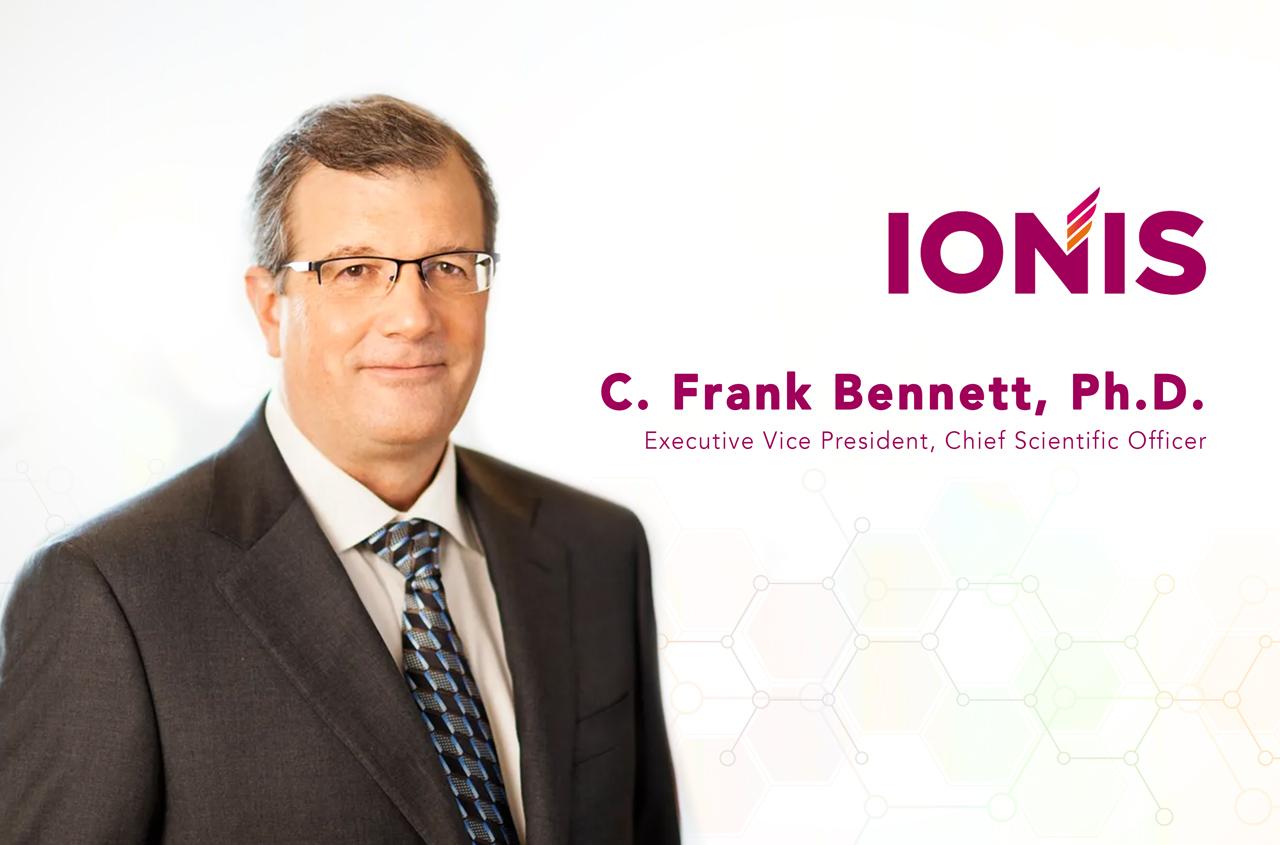Looking for something?
The Journey of C. Frank Bennett: Caring and Curiosity Drive the Development of Antisense Therapies

The chief scientific officer of Ionis Pharmaceuticals, Dr. C. Frank Bennett, is not someone who comes to work just to do science, but to help his patients. Although he started with little knowledge of antisense drugs when he joined the company more than thirty years ago, his patients have remained his greatest source of inspiration in creating life-changing therapies. With more than a dozen antisense drugs now on the market, his caring and curious mindset has led to great success.
Early life and education: natural curiosity leads to scientific pursuits
Frank Bennett grew up in Aztec, New Mexico, where his family owned a small hotel downtown. His interest in science came from exploring the hills of northwest New Mexico; his natural curiosity, combined with the encouragement of his high school mentor, inspired him to pursue a career in science.
While attending the University of New Mexico for his bachelor’s degree in Pharmacy, his University mentor recognized his interest in both pharmacy and chemistry and persuaded him to pursue a career in pharmacology. In 1985, he earned his PhD from Baylor College of Medicine; it was here he met then adjunct professor Stanley Crooke — his mentor and future business partner. After completing his postdoctoral fellowship at SmithKline & French Laboratories, where Crooke was head of research and development, Bennett continued to work at the company as an associate senior investigator before receiving an exciting opportunity from Crooke.
Starting Ionis Pharmaceuticals: advancing the field of antisense therapies
In the late 1980s, as Crooke was starting Ionis Pharmaceuticals — which was then a tiny company operating out of a temporary lab space in Sorrento Valley — he invited Bennett to join him, making Bennet one of the founding and longest-serving members of the company. Joining the company had both professional and personal benefits: Bennett was intrigued by Ionis’s potential to invent a new class of drugs called antisense, which alter how genes work by targeting RNA, and his wife, Paula, was eager to move away from their current home in Philadelphia.
Bennett said that in 1989, they didn’t know anything about making antisense drugs.
“When I first joined Ionis, I was beating my head against the wall for about a year or so trying to get antisense technology to work,” he said. However, he credits Stan Crooke for creating the culture, foundation, and goals for Ionis that made the company’s eventual success possible.
As the executive vice president and chief scientific officer, Bennett’s work at Ionis has advanced antisense technology, expanded the drug delivery platform, and been imperative in developing antisense oligonucleotide research. More than thirty years have passed since the company’s founding, and Frank Bennett continues to believe in the science and the promising future for antisense technology.
Spinraza: creating a drug with a meaningful impact on patients
In 2003, Bennett read a scientific paper that sparked a partnership and eventual treatment for an incurable genetic disease. The paper, written by Adrian Krainer, described how antisense could change the activity of a gene that codes for a protein that promotes the survival of motor neurons. In patients with spinal muscular atrophy (SMA), motor neurons die due to a deficiency in the protein.
“I contacted Adrian to see if he’d be interested in collaborating with us,” Bennett explained. “Adrian, being an academic, didn’t have the ability to see his ideas get translated to therapies… He had the expertise in the basic science, and we had the expertise in translating that basic science into potential therapeutics.”
Bennett said that when he started, he knew very little about SMA, but after attending a national meeting called Cure SMA, where children with SMA were “running around in their wheelchairs being normal kids,” he knew it was something he wanted to find a treatment for.
“These kids have so much life in them, and it’s very motivating to work in this field,” he added.
Thus in 2004, the two men began working together to create an antisense drug for SMA, an often fatal condition that affects one in every 11,000 infants and eventually leads to paralysis. In its most severe form, Type 1 SMA, it can kill infants before their first birthday, when they lose their ability to breathe.
Bennett continued to work on the drug for over a decade, and just as his curiosity had compelled him to explore the hills of New Mexico, it was a series of novel discoveries — and his patients — that kept him going.
At the start of the phase one trial, which was a single dose in relatively healthy SMA patients, Bennett said their best hope was that they would stabilize the disease. However, the results were even more encouraging and showed increased muscle strength. The open-label phase two trial included more severely affected type 1 SMA patients, who also showed improvement after a single dose.
“They were moving around and being able to reach for things, starting to sit, which is never heard of for Type 1 SMA patients,” he said.
Despite the encouraging results, they still had to do a controlled phase three study, which Bennett describes as very hard, especially for the type 1 SMA patients who would likely die of the disease. Bennett admits he still struggles with the control part of a study for some of the patients he’s working on. However, as the trial continued, the evidence that the infants were surviving significantly longer was so undeniable that the trial was stopped ahead of schedule, and all the infants were put on the drug.
“It’s a once in a lifetime opportunity to actually work on a drug that has this kind of meaningful impact on patients,” Bennett said.
The data for the control study was received in August, and at 4 p.m. on the Friday before Christmas in 2016, Bennet and his team got a call from the FDA that their drug had received approval. Twenty-two years after the SMA gene was identified by Judith Melki and her team, treatment would be available.
Sold as Spinraza, it’s the first drug found to not only stop the impacts of SMA but also help patients regain functions they’ve lost or never had. Spinraza also has a profound effect if given to infants within a few weeks of birth.
“It was a very nice Christmas present for SMA patients and their families, as well as for myself and Ionis,” he said.
Frank Bennett and Huntington’s patients meet the pope
Based on the success of Spinraza, there are now a vast number of additional drugs for neurological diseases in clinical stages and several drugs in preclinical development. The hope, Bennett explained, is to have a rich pipeline of approved drugs.
However, clinical trials and science are only one part of finding a cure. Meeting with patients and understanding their lives not only informs Bennett’s drug development goals but motivates him to come to work every day.
“I don’t come to work just to do science. I come to work every day to help patients,” he said.
Bennett’s patient involvement led him to the Vatican in 2017, where he attended a historic meeting between Pope Francis and Huntington’s disease patients and advocates.
“It was a life-affirming event. I’m not religious myself, but the pope is clearly somebody who cares about people, and it comes through very strongly. I’ll remember it for the rest of my life.”
The Ionis antisense drug for Huntington’s disease, marketed as Tominersen, is currently in a Phase two clinical trial called GENERATION HD2. After the phase three trial was cut short, post hoc analysis determined that the drug may benefit younger patients who had less advanced symptoms of HD. The new trial is using lower doses to treat these patients than had been used in the Phase three GENERATION HD1 trial and will focus on safety and whether Tominersen is properly hitting its target.
Breakthrough Prize in Life Sciences
In 2019, much to Bennett’s surprise, he received news that he and Krainer had won the Breakthrough Prize in Life Sciences for Spinraza.
“It took a while to process,” he said.
Accepting the prize at a gala ceremony, he thanked the many people who helped, including his source of inspiration: the patients and families who participated in the clinical trials. His mentor and colleague, Crooke, was not forgotten in the speech as Bennet thanked him for teaching him that it’s possible to do creative and impactful science in industry and the power of saying yes.
In 2018, he was also awarded the Hereditary Disease Foundation’s Leslie Gehry Prize for Innovation in Science for his commitment to developing antisense therapies for Huntington’s disease, and in 2021, he received The OTS Lifetime Achievement Award.
Rainwater Prize
His leadership and work in the field continue to be recognized, with a recent announcement in 2023 that he has been named a co-recipient for the Rainwater Prize for Outstanding Innovation in Neurodegenerative Disease Research, which recognizes treatment and research progress for diseases associated with the accumulation of tau protein in the brain.
Frank Bennett, Don Cleveland, and Timothy Miller are being recognized for their work in advancing antisense technology for treating neurodegenerative diseases, including amyotrophic lateral sclerosis (ALS), Huntington’s disease, Alzheimer’s disease, and tauopathies.
“I’m humbled to be recognized by the Rainwater Charitable Foundation with this prestigious award. It represents an affirmation for the work that everyone at Ionis is doing to deliver transformational genetic medicines to patients battling grave diseases,” Bennett said. “I am equally honored to share the prize with my esteemed colleagues, Drs. Cleveland and Miller, whose expertise, dedication and tireless efforts have contributed significantly to bringing hope to patients and their families.”
Patients deserve recognition for trying a novel therapy
While Bennett accepts his accolades with humility and grace, he always brings the attention and credit back to the families and the kids with the conditions, calling them the true heroes deserving of the most honor.
“They were very brave to try a very novel therapy for the first time,” he said. “And for the first few patients, there was a lot of risk associated with it. We had done all the work that we could to show that it was safe, but you never know when you’re testing a new medicine.”
As antisense therapies for neurodegenerative conditions continue to be tested and marketed, potentially changing the landscape of diseases once thought to be incurable, the world is fortunate to have a scientist so invested and inspired by the people needing a cure. Bennett encourages young people to follow their dreams, saying that you’ll be successful if you’re passionate about your work. His accomplishments are evidence that this is true.








